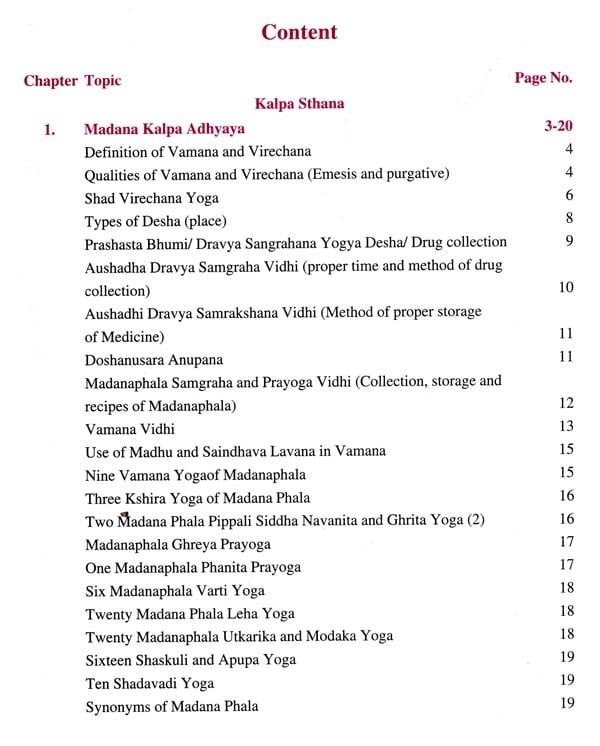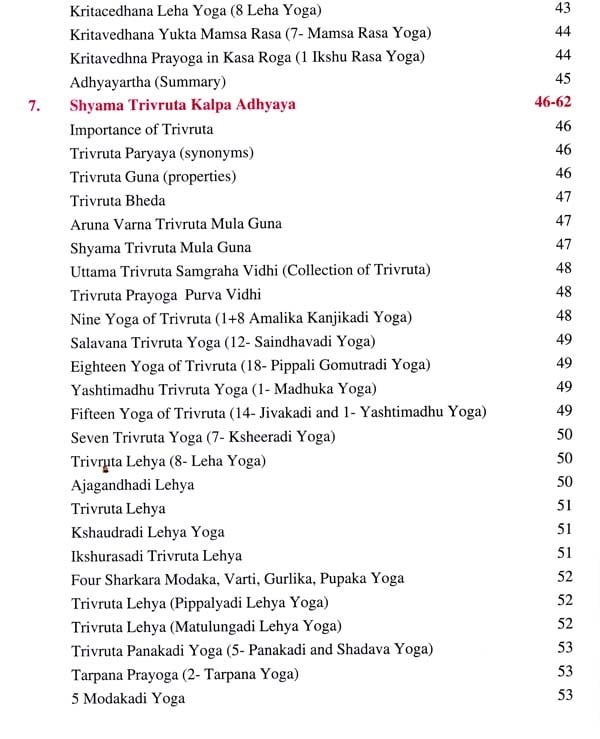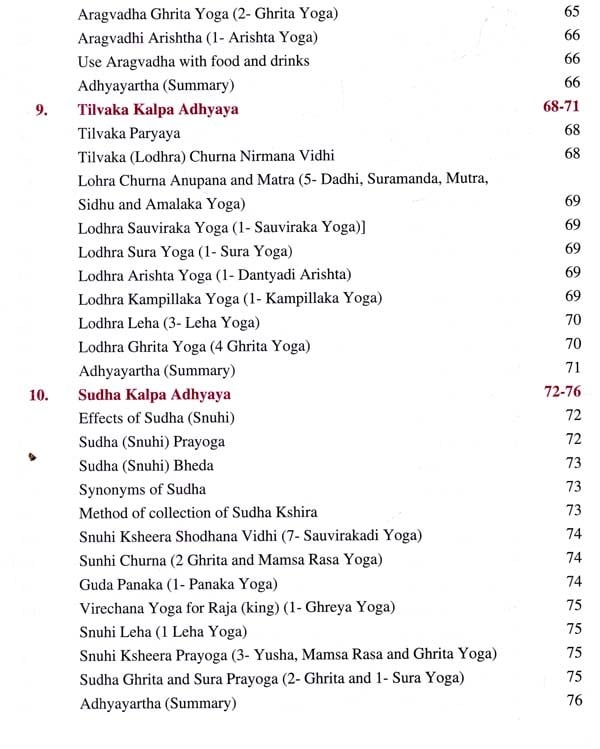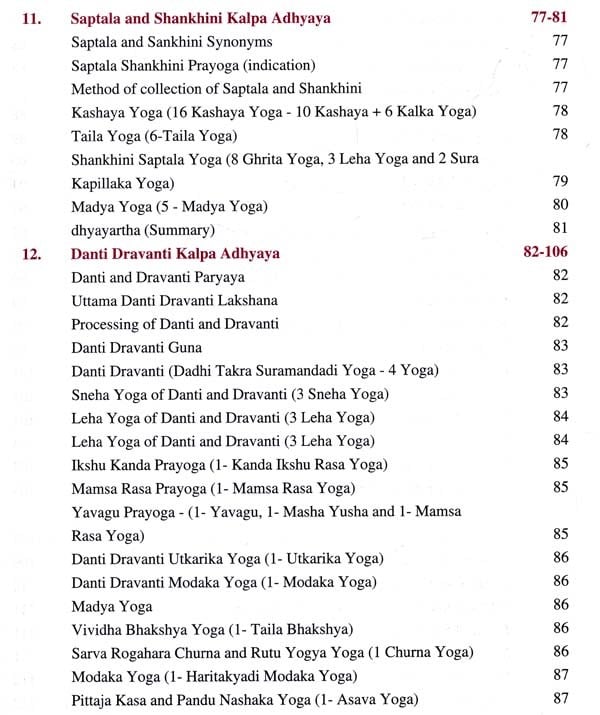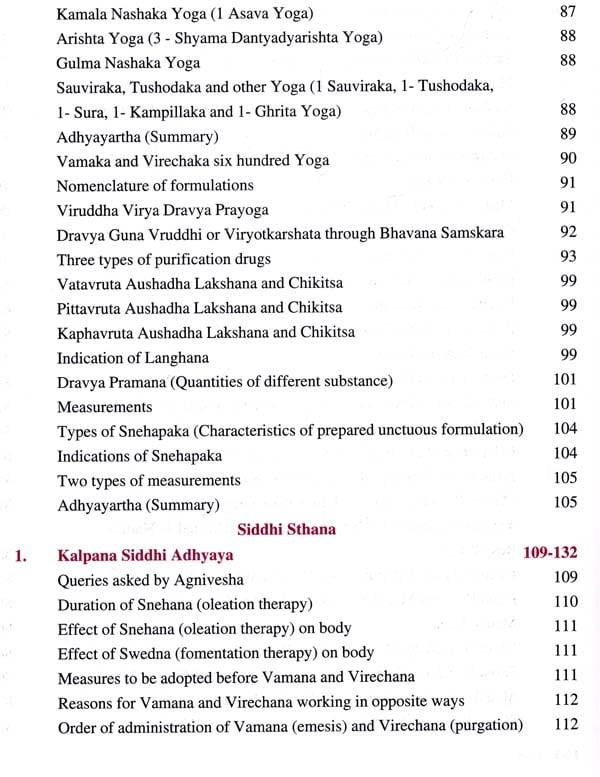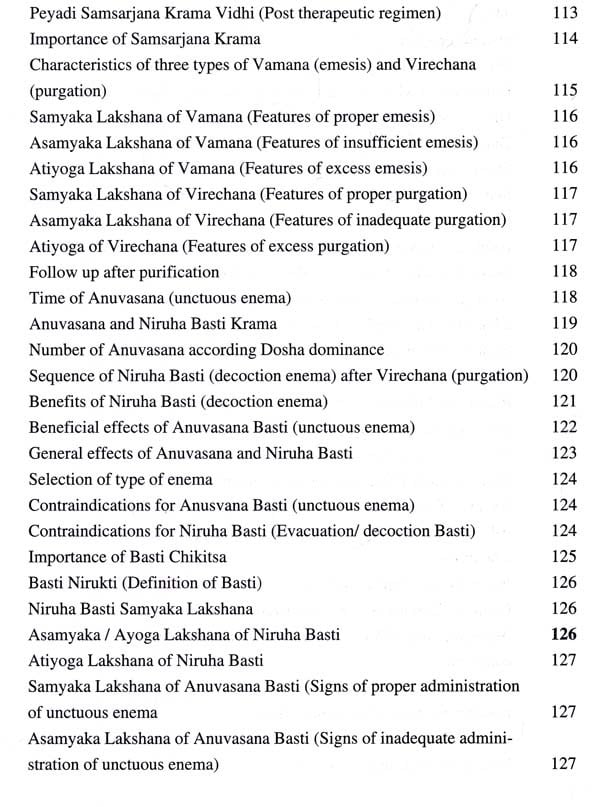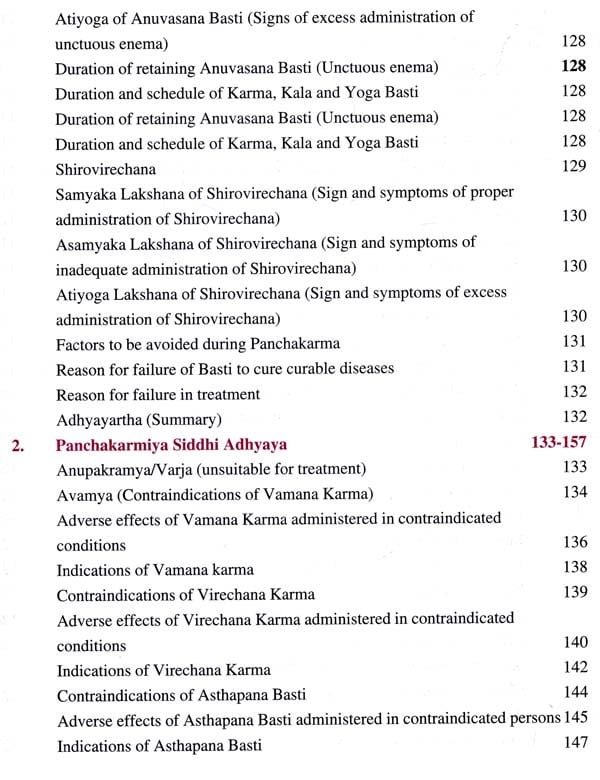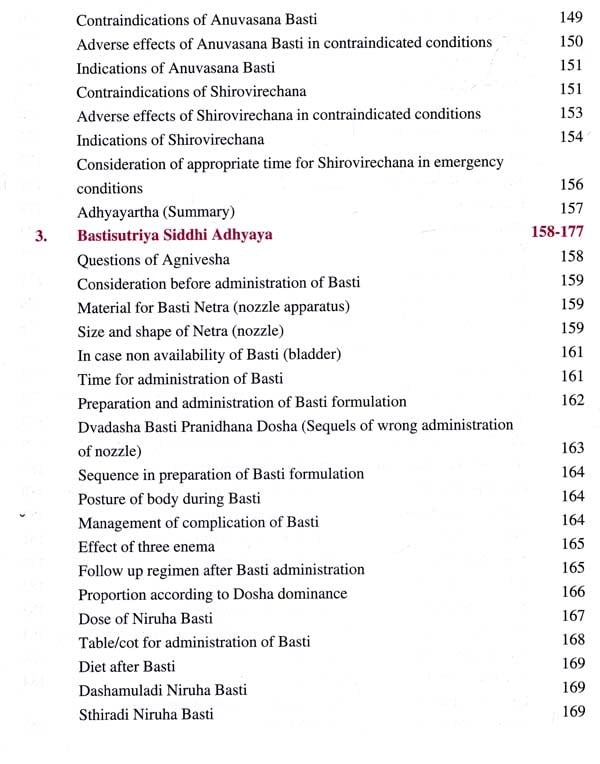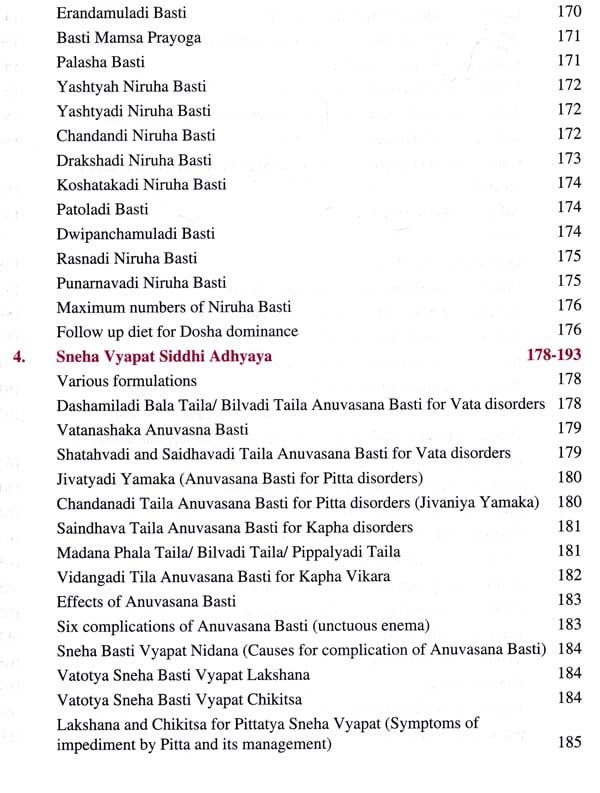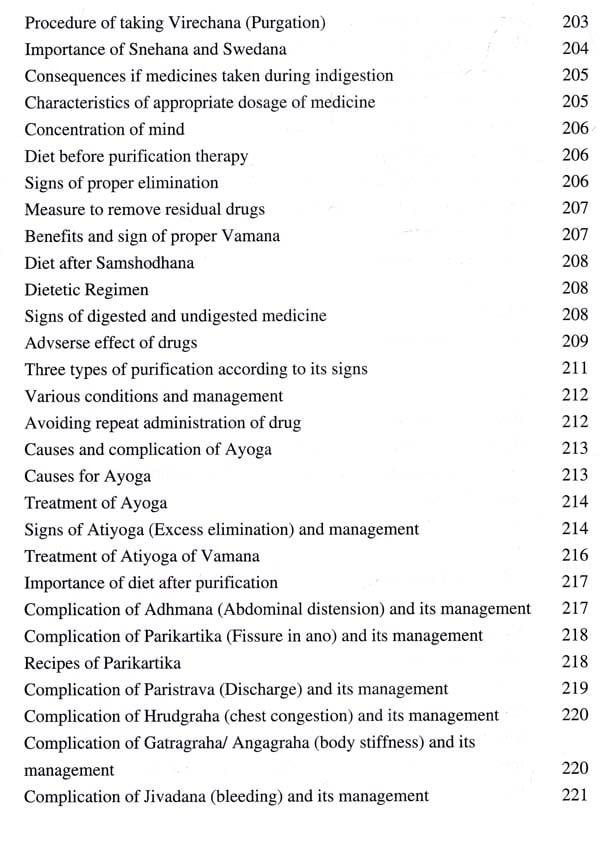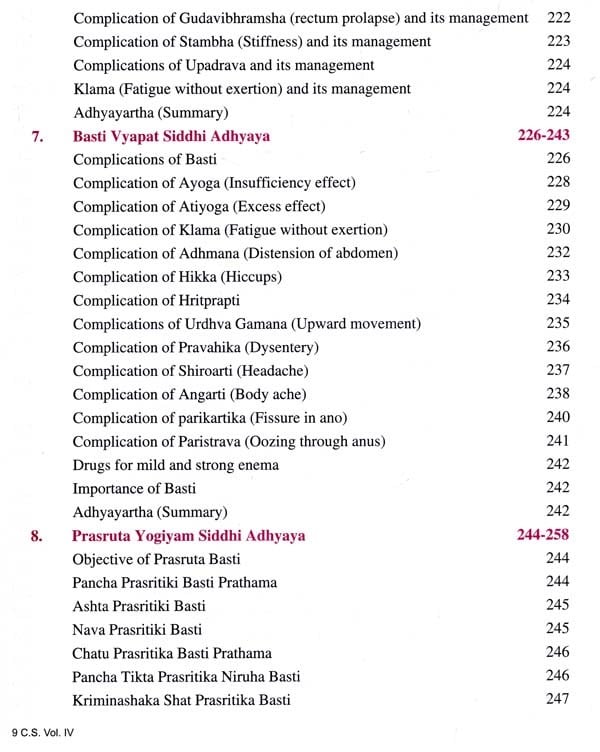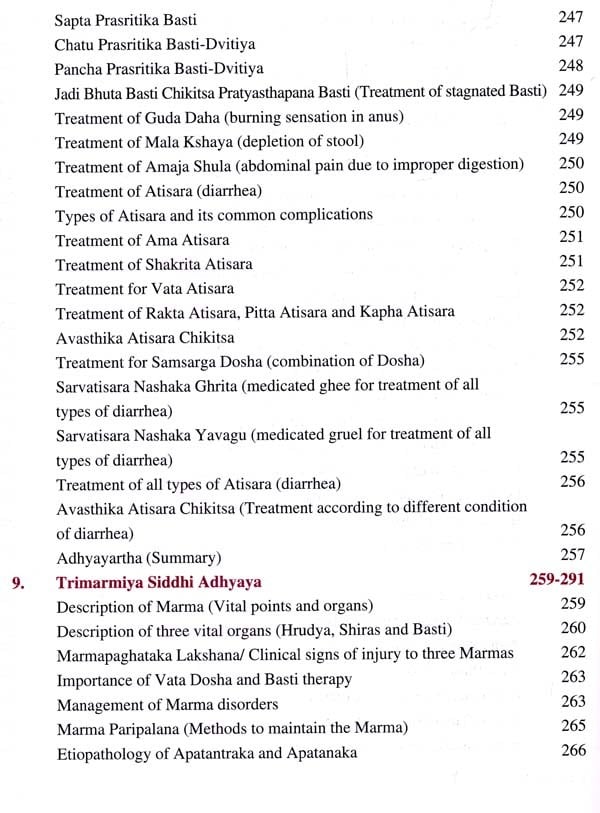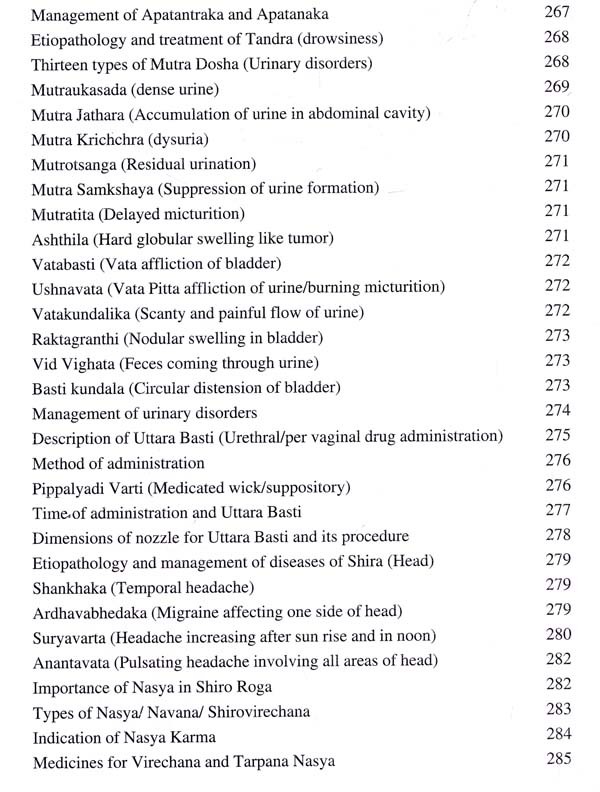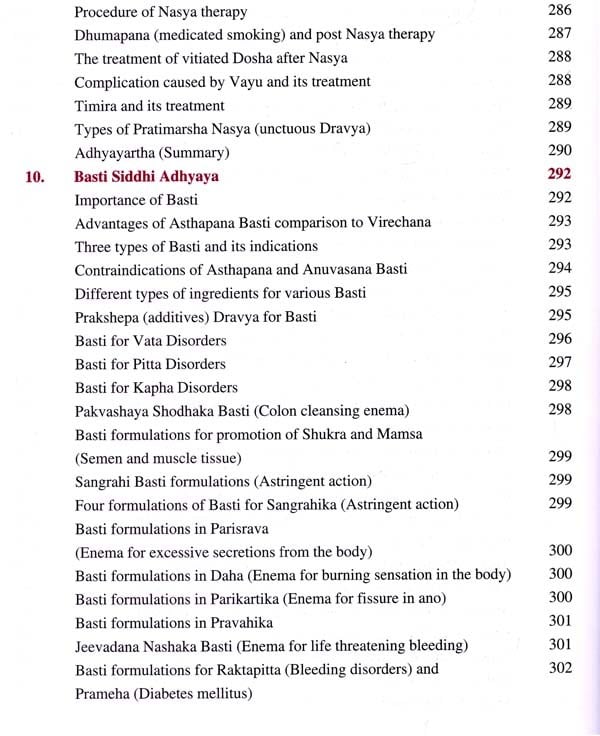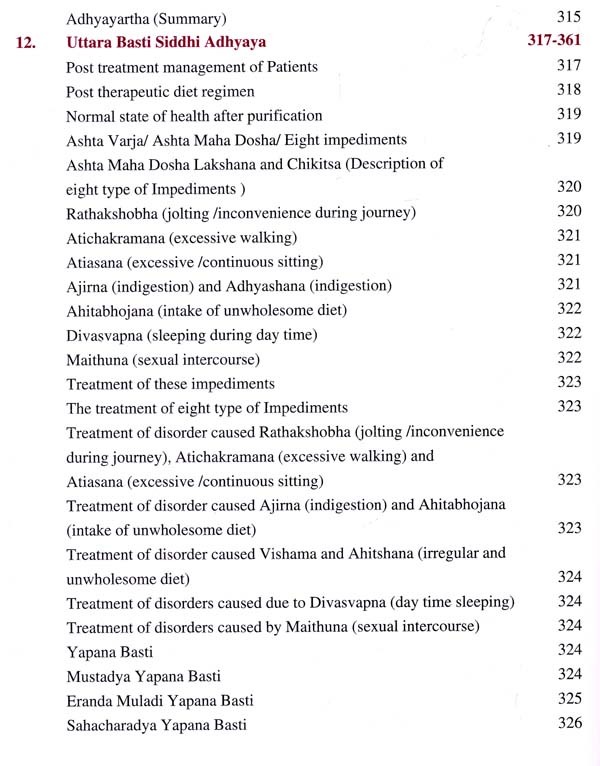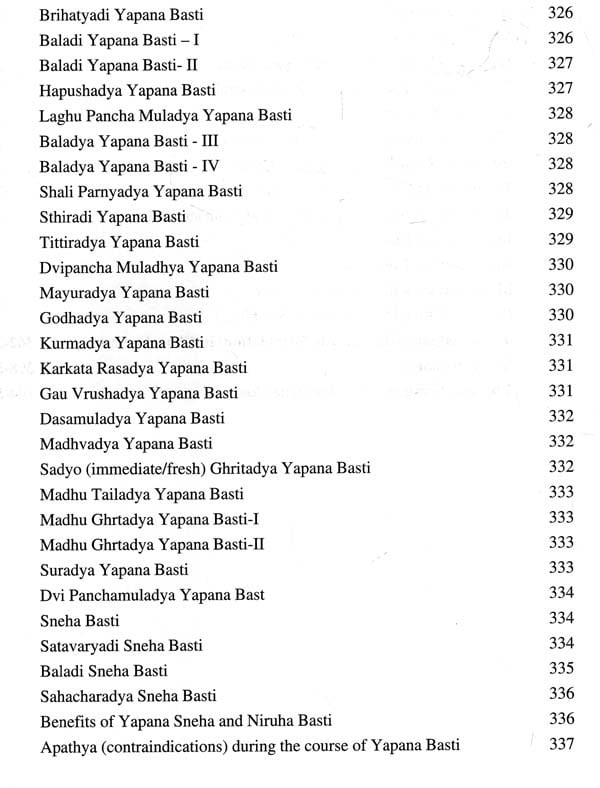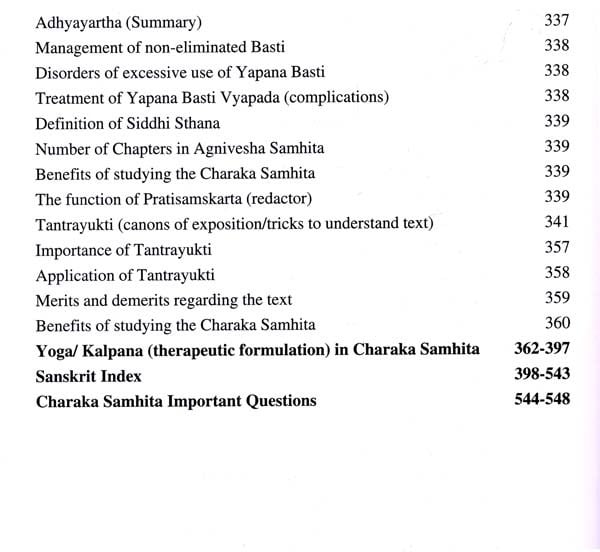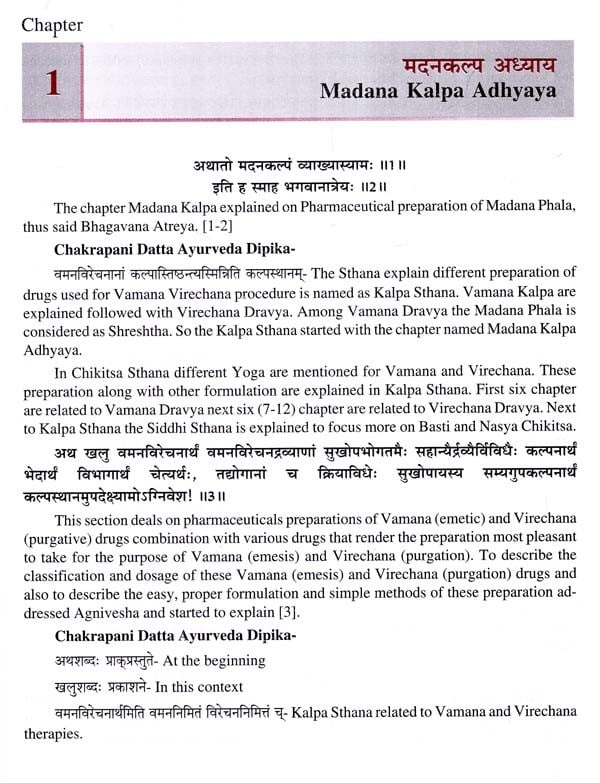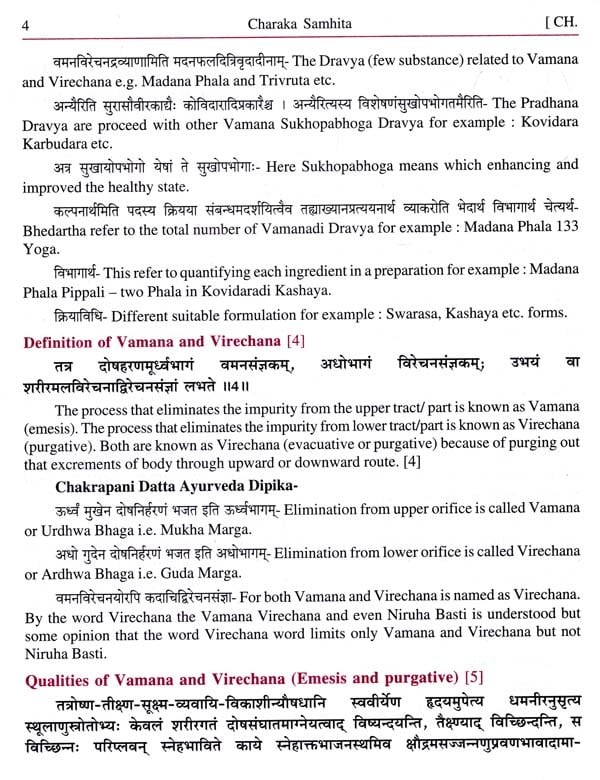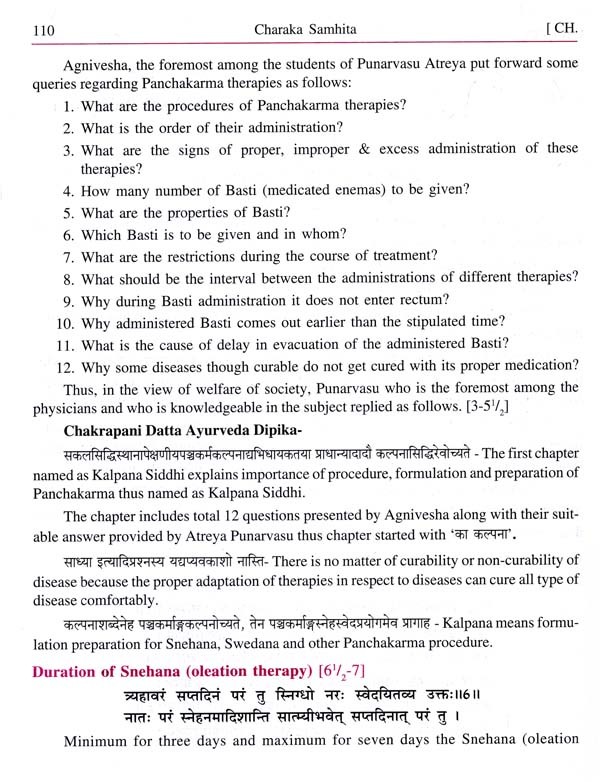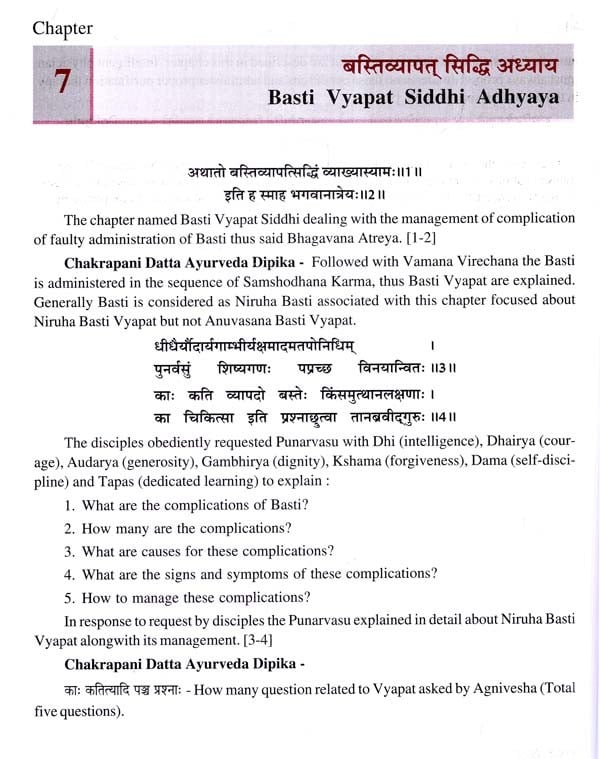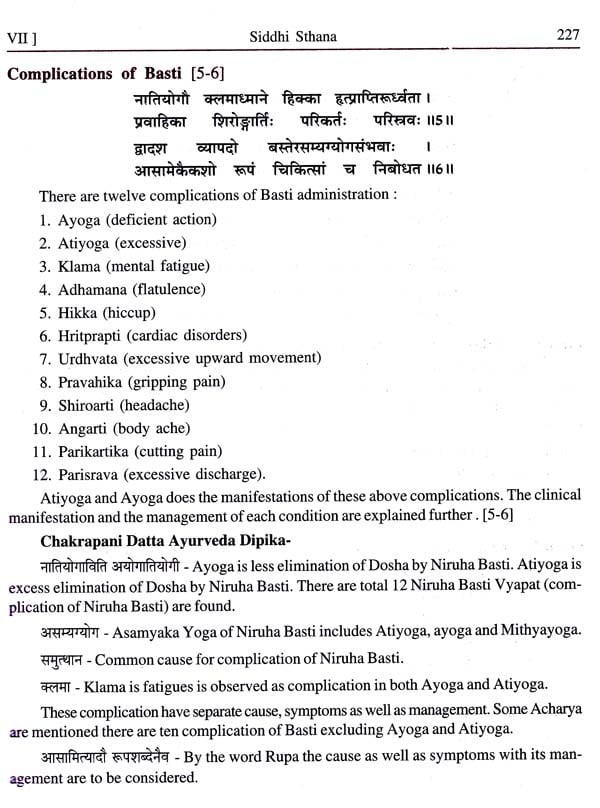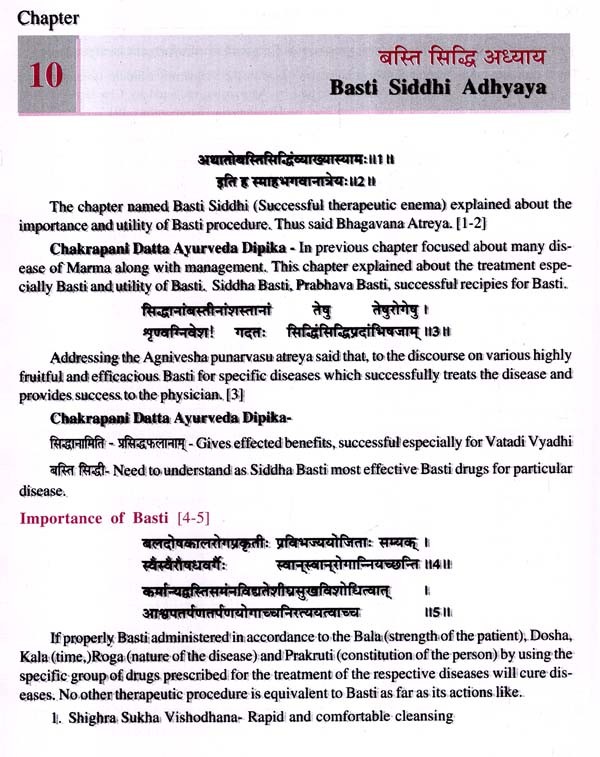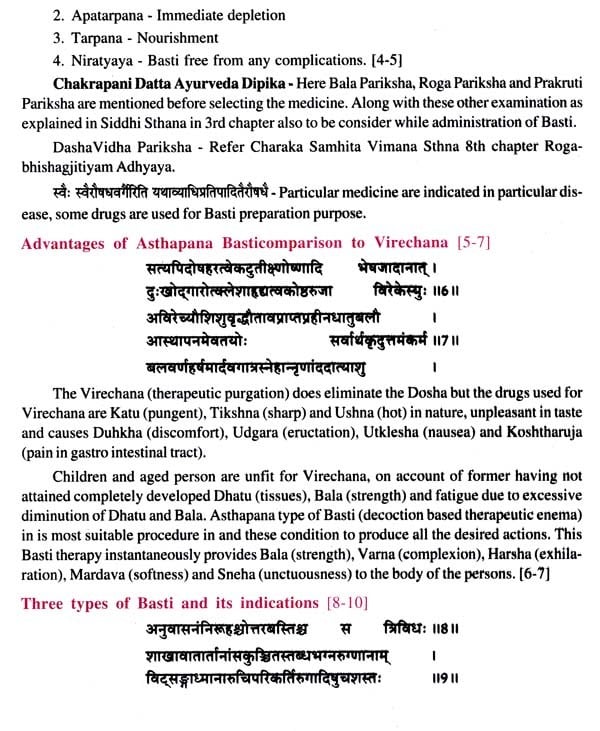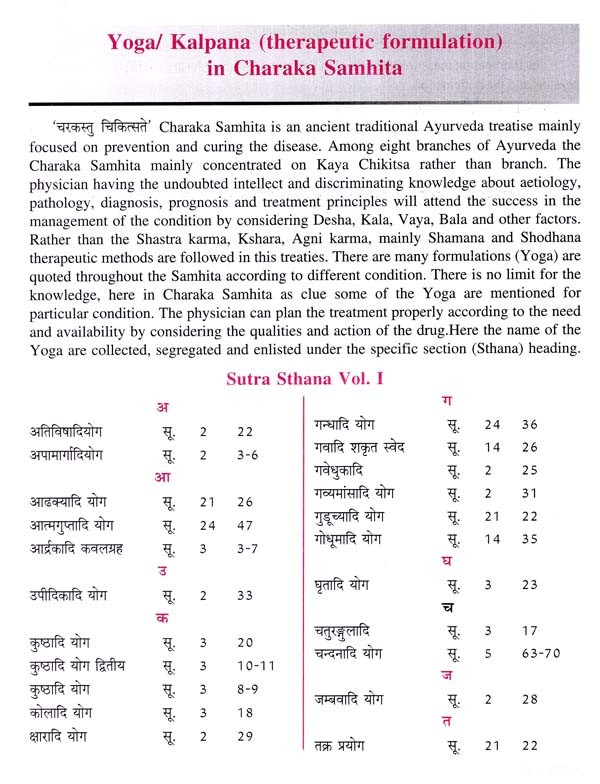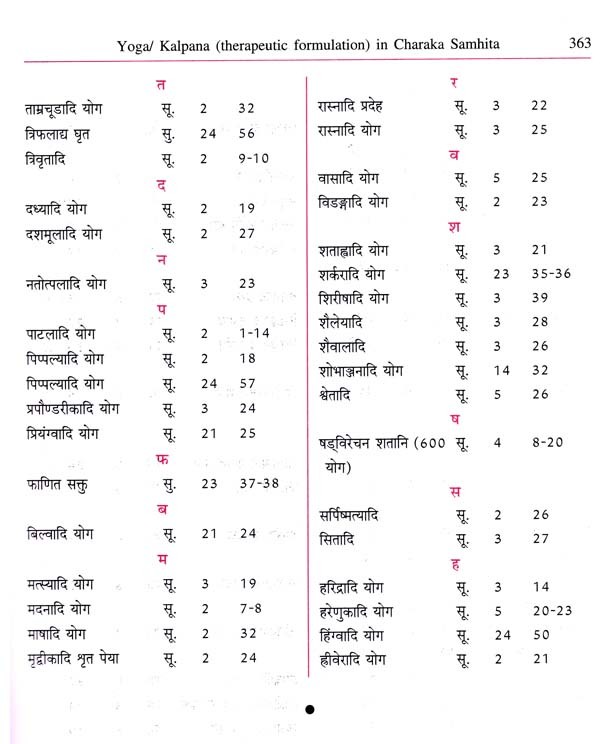
Charaka Samhita- Kalpa Sthana, Siddhi Sthana and Shloka Index (Vol-V)
Book Specification
| Item Code: | NBZ260 |
| Author: | Shashirekha H. K. And Bargale Sushant Sukumar |
| Publisher: | Chaukhambha Publications |
| Language: | Sanskrit Text with English Translation |
| Edition: | 2018 |
| ISBN: | 9789381608982 |
| Pages: | 618 |
| Cover: | HARDCOVER |
| Other Details | 10.00 X 7.50 inch |
| Weight | 1 kg |
Book Description
We feel extremely happy to bring you "Charaka Samhita" the text with English translation. The book is unique of its kind as if is conceived as per the needs of B.A.M.S. Graduates, beginners of Ayurveda as well as allied subject seekers. We have attempted to bring before you the best treatise of Ayurveda of Agnivesha in very simple and easy English along with relevant explanations from commentaries wherever necessary.
We are thankful to our dearest students community for over whelming response for our earlier "Text book of Swasthavritta" and hope to receive the similar encouragement for this endeavor also.
Dr. Shashirekha H. K., Born in Hassan, Kamataka. She was completed Graduation (2006) and Post Graduation in Ayrveda Samhita (2010) from Rajiv Gandhi University of Health Science, Bangalore, Kamataka and Ph.D. in Ayurveda (Samhita) from Tilak Maharashtra Vidyapeeta, Pune Maharashtra. M.A. (Sanskrit) from Kamataka State Open University Mysore, Kamataka, M. Sc. (Psychology) from Madurai Kamaraj University, Madurai, Tamil Nadu and M. Sc. (Yoga) from Periyar University (PRIDE), salem, Tamil Nadu. She published more than 15 papers in various Peer Reviewed International Journal. Currently she is working as Associate Professor in the Department of Samhita- Siddhanta at Sri. Dharmasthala Manjunatheshwara College of Ayurveda and Hospital Hassan, Kamataka. She is acclaimed teacher for graduate and post graduate scholars.
Dr. Bargale Sushaot Sukumar, Born in Sangli, Maharsahtra. He has completed Graduation (2006) and Post Graduation in Swasthavritta (2010) and Pursuing Ph. D. in Ayurveda (Swasthavritta) from Rajiv Gandhi University of Health Science, Bangalore, Karnataka. He has completed M. Se, (Yoga) from Periyar University (PRIDE), Salem, Tamil Nadu and M. Sc. (psychology) from Madurai Kamaraj University, Madurai, Tamil Nadu. Currently he is working as Assistant Professor in the Department of Swasthavtitta and Yoga at Sri. Dharmasthala Manjunatheshwara College of Ayurveda and Hospital Hassan, Karnataka. He has published many articles in National and International Peer reviewed journals and presented more than 8 papers in various International and National conferences.
Kalpa Sthana Kalpa Sthana of Charaka Samhita deals with different dosage forms of Vamana (emetics) and Virechana (purgative) drugs along with their therapeutic application in various diseases. Kalpa Sthana contains the descriptions of Vamaka (emetics) and Virechaka (Purgatives) drugs. Six drugs namely Madanaphala, Jimutaka, Ikshvaku, Dhamargava, Kutaja and Kritavedhana are denoted for emesis while nine drugs namely Shyama, Trivrut, Chaturangula, Tilvaka, Mahavrikshaka, Saptala, Sankhini, Danti and Dravanti are described for purgation. Atreya formulated 600 preparation including both emetic and purgative recipes from fifteen drugs. Emetic drugs predominantly constituted by Agni and Vayu Mahabhutas whereas Virechaka drugs constituted by Prithvi and Jala Mahabhutas. It is also observed that drugs with these Panchabhautika compositions may not exert either emetic or purgative action and the activity is attributed to general principle of drug action known as Prabhava.
Virya (a principle responsible for each and every drug action) is augmented by Desha sampat (quality of soil in which plant grows), Kala sampat (Ideal season for collecting the plant), Guna sampat (enrichment of principles of drug action) and Bhajana sampat (suit-ability of storage containers) contributing to maximum therapeutic effect. Chakrapani comments that container to be used for the storing drugs that including all Guna (attributes) similar to the stored drugs. Different adjuvants (Anupana) are required to be used in accordance with Doshas involved in the pathogenesis of disease during the administration of drugs. Recipes are prepared based on the Dravya (Nature of drug), Deha (Physique), Dosha (factor for causation of diseases), Prakruti (Constitution), Bala (Strength), Satmya (Homologation), Rogavastha (stage of the disease), Vaya (age), Agni (digestive and enzymatic complexes) etc. Before the administration of emetic therapy Snehana (oral oleation therapy) and Swedana (fomentation) are mandatory. Administered drug first reaches the heart and circulated all over the body through Dhamani (Blood vessels) and liquefy morbid matter (Mala) and separate it from channels and bring them to Koshta. Emetic and purgative drugs facilitate the expulsion of Malas brought into Koshta from rest of the body. Drugs for emesis which are Ushna (hot), Tikshna (sharp/penetrating), Sukshma (subtle), Vyavayi (pervading), and Vikashi (loosening), by virtue of their own potency (Swa Viryena), reach the heart and circulate throughout the body through vessels. It liquefies the mass of impurities by its Agneya nature (dominance of Agni Mahabhuta) and due to Tikshna Guna (penetrating property) separate the adhered Doshas situated in gross and subtle channels of the entire body. Consequently the separated mass floating in the oleated body reaches the stomach like honey kept in a fat smeared vessel because of its nature to move through subtle channels (Anumarga Sancharitwat) and to flow towards gastro- intestinal tract (Koshta Gamanonmukhatwam). Because of the predominance of Agni and Vayu Mahabhuta in these drugs, their specific action (Prabhava) to move upwards and Udana Vata, the morbid matter gets expelled through the upward tract (mouth).
Six emetic drugs Jimutaka, Ikshvaku, Dhamargava, Kutaja and Kritavedhanaare described in separate chapters. Dridhabala who redacted Kalpa Sthana (section on pharmaceutics) has described individual drugs with synonyms. Chakrapani opines that Madana Phala is relatively safe in comparison to other emetic drugs and rest of the drugs produce more untoward side effects in the ascending order. Fruits and flowers of Jimutaka are used as emetics and other parts like leaves and branches of this plant are not useful for Vamana Karma (therapy of emesis).
In 2nd chapter of Kalpa Sthana Jimutaka Kalpa chapter, 39 preparation of Jimutaka processed in various media like milk, alcohol, water etc. are enumerated. In the context of Vati (pill) preparation it is suggested to prepare them in the size of Kola (1/2 Tola- 6 gm) in comparison to Madana Phala (in pill form) which can be administered in the quantity of Haritaki (2 Tola), Vibhitaki (1 Tola) and Amalaki (1/2 Tola). It appears that Jimutaka produces emesis relatively in small doses. Jimutaka is bestowed with Tridoshahara karma (curing vitiated conditions of Tridosha) and indicated in the treatment of Jwara (fever), Pittashleshma Jwara, Vatapitta Jwara, Swasa (asthma), Hikka (hiccough), Arochaka (anorexia), Kasa (cough), Pandu (anaemia), Rajayakshma (wasting diseases) and such other diseases. Drugs like Guduchi, Yashti, Kovidara, Karbudara, Nipa, Vidula, Bimbi, Shanapushpi, Sadapushpi, Pratyalipushpi, Nimba, Kutaja, Aragwadha, Swadukantaka (Babbul or Gokshura), Patha, Gunja, Patala, Murva, Jivaka, Rishabhaka, lkshu, Shatavari, Madanaphala etc. are also incorporated along with Jimutaka in various formulations.
In 3rd chapter of Kalpa Sthana Ikshavaku Kalpa, explain about 45 recipes of Ikshavaku processed in various media like milk, alcohol, whey, buttermilk, oil cake, clarified butter, meat soup etc. are described. The useful parts are leaves, flower and seeds of Ikshavaku are employed for emesis. A recipe with administration of seeds in an increasing dose from fifty up to maximum hundred seeds per day is described. Ikshavaku is indicated in conditions like Kasa (cough),Shwasa (dyspnea/asthma),Chardi (vomiting), Jwara (fever), Visha (toxin), Swarabheda (hoarseness), Peenasa (coryza), Gulma (lump in abdomen), Udara (ascites), Granthi (cystic swelling), Galaganda (goiter), Shleepada (elephantitis), Pandu (anemia), Kushtha (skin disorders), Arochaka (dyspepsia), Prameha (diabetes). Emesis induced by inhalation of powdered flower sprinkled over a garland is also described in this chapter. Drugs like Yashti, Kovidara, Karbudara, Nipa, Vidula, Bimbi, Shanapushpi, Sadapushpi, Pratyakpushpi, Bilwamoola, Mahajaalini Jimutaka, Kritavedhana and Kutaja etc. are also incorporated along with Ikshavaku in various formulations.
In 4th chapter of Kalpa Sthana Dhamargava Kalpa for the purpose of inducing Vamana (emesis). For this, its tender leaves, fruits and flowers are used. Total 60 preparations by using different medium like milk, juice of cow dung, horse dung, ghee, alcohol and decoction of various drugs like Dhanyaka, Tumburu etc. In this reference Vati (pill) is prepared of the size of Kola (Jujuba). In one preparation emesis is induced after inhaling the powdered fruit sprinkled over the flower of water lily etc. Dhamargava is used to treat Gara Visha (poisoning), Gulma (Lump in abdomen), Udara Roga (ascites), Kasa (cough), Mano Vikara (mental disorders) and various chronic deep seated diseases.
In 5th chapter of Kalpa Sthana Vatsaka Kapla, its synonyms, and the difference between male and female plants (along with their pharmaceutical preparations) are described. The seeds of Vatsaka are known as Indrayava or Kalingaka. Fruits and seeds are used for therapeutic emesis. Vatsaka is used to treat Raktapitta, Kapha, Vatarakta, Visarpa and several other diseases. Total eighteen formulations are prepared in different medium like decoction of various drugs, water and Krasara, it is beneficial for delicate persons.
In 6th chapter of Kalpa Sthana Kritavedhana Kalpa is used in treatment of deep seated diseases like Kushtha (skin disorder), Pandu (anemia), Gulma (lump in abdomen), Gara Visha (slow poisoning), etc. Total sixty preparations are made using different mediums like milk, alcohol, decoctions, meat, sugarcane juice, etc. It is very pungent, sharply acting and hot. Parts used are flowers and dried fruits for inducing emesis. It has emetic activity due to Tikta Rasa, Tikshna Guna, Ushna Virya and most important its Ubhayto Bhagahara Prabhava.
In 7th chapter of Kalpa Sthana Shayama Trivruta Kalpa deals with the pharmaceutical preparations for Virechana karma (purgative therapy) using Shyama and Trivrita. Trivrita, is considered best purgative because of its effectiveness and minimal side effects. The chapter describes synonyms of the plant, its morphology, pharmacological properties, the varieties of plant with their different indications and untoward effects. The method of collection of the plant part used i.e. the root did its storage are also described. Then, one hundred and ten preparations using Trivrita or Shyama or combination of these two drugs are enlisted. Proportions of different drugs that are to be used along with the main drug are discussed and the dosage to different individuals is also presented. Recipes made of Trivrita or Shyama are formulated in such a way to suit any individual depending upon the seasons and climatic conditions.
In 8th chapter of Kalpa Sthana Chaturangula/Aragvadha Kalpa, just likeTrivruta, is a mild purgative. The chapter deals with synonyms of Chaturangula, the therapeutic utility, various methods of processing of Aragvadha, method of administration of the pulp of Aragvadha in different age groups, other recipes of Aragvadha. Total twelve different formulations of Aragvadha to suit different needs of the physician have been discussed in this chapter.
In 9th chapter of Kalpa Sthana Tilvaka Kalpa deals with preparations of Tilvaka for the purpose of Virechana (Therapeutic purgation). Tilvaka is considered as mild purgative the chapter includes the therapeutic utility of Tilvaka, methods of processing of Tilvaka bark, method of preparation and administration of Tilvaka Churna are detailed here. Other recipes of Tilvaka viz., Sauviraka, Sura (alcoholic beverages) along with a total of sixteen different formulations of the same drug to suit different needs of the physician has been discussed in this chapter.
In 10th chapter of Kalpa Sthana Sudha Kalpa deals with the preparations of Sudha for the purpose of Virechana (therapeutic purgation). Sudha is a strong purgative in comparison to all other drugs discussed in previous chapters. The chapter includes synonyms of Sudha, its therapeutic utility, varieties, limitations for the usage, methods of collection, purification, preparation and administration of Sudha Ksheera and other recipes viz. Vati (tablets), Leha (linctus) and other preaparation along with total twenty different formulations of the same drug to suit different needs of the physician. Even though it is contraindicated for Mrudu Koshti (sensitive to mild laxatives) its usage has been advised here by altering its form to reduce its untoward effect.
**Contents and Sample Pages**
